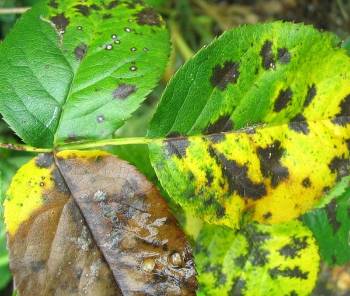Black Spot on Roses
Searcy, Ark. –
 Black spot, caused by the fungus Diplocarpon rosae, is the most significant disease affecting roses in Arkansas. Rose growers must take
steps annually to manage this pervasive problem, which impacts most rose varieties.
Black spot, caused by the fungus Diplocarpon rosae, is the most significant disease affecting roses in Arkansas. Rose growers must take
steps annually to manage this pervasive problem, which impacts most rose varieties.
Susceptibility of Rose Varieties
Hybrid tea roses are particularly vulnerable to black spot, though the fungus can infect all types of roses. The disease develops best under conditions of 75°–85°F with high relative humidity or rainy weather. When leaves stay wet for six or more hours, the fungus infects them, and canes may also be affected. Greenhouse-grown roses are less prone to black spot since temperature and humidity are controlled.
Symptoms of Black Spot
The most characteristic symptoms are black, round spots with feathered edges, up to 1/2 inch across, usually on the upper leaf surface. Yellow halos often surround the spots. When multiple spots occur, they cause leaves to turn yellow and fall off. The infection typically begins on lower leaves, and excessive leaf drop weakens the plant, making it more vulnerable to other issues. Under favorable conditions, new spots can appear within five days.
Spread of the Disease
Periods of rainfall or overhead watering increase the risk of black spot outbreaks. Wet conditions allow the fungus to produce thousands of spores on infected leaves and canes, which are spread by wind or splashing water. Because the fungus tolerates a wide range of temperatures, it can remain active throughout the growing season if moisture persists.
Prevention through Resistant Varieties
Planting resistant rose varieties is the best preventive measure. While some resistant varieties may develop low levels of black spot, they require less maintenance. A list of recommended resistant varieties can be found at this link.
Sanitation Practices for Control
Effective sanitation is critical since the fungus survives on fallen leaves and dying canes. All dead or diseased material should be removed and disposed of before new growth appears in spring. If practical, infected leaves still on the plant should also be removed to prevent further spread.
Watering Strategies to Minimize Infection
Overhead irrigation, which prolongs leaf wetness, should be avoided. If overhead watering is necessary, it should be done early in the morning to reduce the time leaves stay wet. Drip irrigation or soaker hoses are preferred. Planting roses in sunny, well-drained locations with good air circulation will also help reduce moisture buildup on leaves.
Fungicide Use for Control
For growers facing recurring black spot issues, fungicide applications are often necessary alongside good sanitation practices. Homeowner fungicides effective against black spot include:
- Spectracide Immunox
- Fertilome Liquid Systemic Fungicide
- Ortho Funginex
- Greenlight Fung-Away
By Sherri Sanders
County Extension Agent - Agriculture
The Cooperative Extension Service
U of A System Division of Agriculture
Media Contact: Sherri Sanders
County Extension Agent - Agriculture
U of A Division of Agriculture
Cooperative Extension Service
2400 Old Searcy Landing Road Searcy AR 72143
(501) 268-5394
ssanders@uada.edu
The Arkansas Cooperative Extension Service is an equal opportunity institution. If
you require a reasonable accommodation to participate or need materials in another
format, please contact your County Extension office (or other appropriate office)
as soon as possible. Dial 711 for Arkansas Relay.
Pursuant to 7 CFR § 15.3, the University of Arkansas System Division of Agriculture
offers all its Extension and Research programs and services (including employment)
without regard to race, color, sex, national origin, religion, age, disability, marital
or veteran status, genetic information, sexual preference, pregnancy or any other
legally protected status, and is an equal opportunity institution.